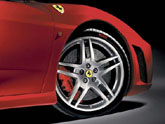Recent Articles
Popular Makes
Body Types
2006 Ferrari F430 Preview
Building in the 360 Modena
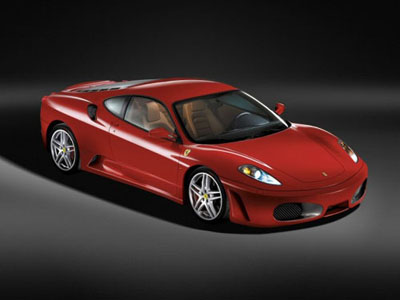
IRVINE, CA – When you sell cars to the wealthiest people in the world, you cannot afford to rest on your laurels – even if you’re Ferrari and you lean against the considerable reputation of the 360 Modena. Today it may be your best-selling model, true -- but allow competitors like Lamborghini and Porsche to surpass you and today’s hot topic will surely turn into tomorrow’s gauche cliché. It’s a simple fact of the exotic market: Wealthy clientele do not like to wait to possess the next new thing, and competition is keen to capture their fickle attention. Ferrari, of course, knows well how the game is played. Which is why they unleashed upon the world the new F430 at the 2004 Paris Auto Show, based upon and replacing the popular 360 Modena in the Italian sports car builder’s lineup, Ferrari says the new F430 is 70 percent new. Aside from the general profile and proportions of its two-seat, mid-engined configuration, it’s hard to detect the portion of the 360 Modena that remains. Modifications to the 360 Modena’s aluminum semi-space frame chassis result in a 20-percent increase in torsional stiffness for the 2006 Ferrari F430. The wheelbase is identical to the 360 and the F430 is a smidge longer, but width and height have been reduced to keep Ferrari’s entry-level model from growing larger than it is today. Curb weight is up about 125 pounds, to 3,190, but the more muscular V8 engine easily makes up for the additional heft.
Page 2: Horsepower
With more than 100 added horsepower over the 360 Modena, the new Ferrari F430 will likely fly down the highway despite the weight gain. The 4.3-liter V8 engine, fired by a red “start” button located on the steering wheel, is a larger-displacement version of the 4.2-liter V8 that Ferrari developed for Maserati, generating 490 horsepower at 8,500 rpm and 343 lb.-ft. of torque at 5,250 rpm. Not only is this power output rated significantly higher than the outgoing 360 Modena, but it also bests the Ferrari F40 supercar of the late 1980s.Power flows to the massive 19-inch rear wheels through a six-speed sequential manual transmission, operated F1-style via paddles mounted to the steering wheel. In the Ferrari F430, shifts take just 150 milliseconds, which should result in a far more satisfying driving experience. At this writing, it is not known whether a traditional manual transmission will be available for purists who shun the advance of technology. Ferrari says acceleration from zero to 60 mph will take less than four seconds, and that the new F430 can reach a top speed just shy of 200 mph thanks in part to its aerodynamic underbody design and carbon-fiber rear diffuser panel which produce plenty of downforce at higher speeds. Special launch control software for the standard traction and stability control system helps to maximize the ratio of tire grip and wheelspin to produce the quickest acceleration possible. Above 3,600 rpm, a special valve bypasses a portion of the exhaust silencer, amplifying Ferrari’s signature howl as the driver winds through the gears.
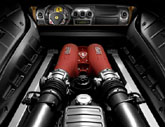
Page 3: E-Diff
To keep the Ferrari F430 under control while powering out of turns, a new E-Diff electronic rear differential, originally developed for Ferrari’s F1 racing program, regulates the distribution of engine torque to the wheels to increase traction and limit oversteer. E-Diff joins an impressive roster of vehicle dynamics control systems on-board the new F430. Electronic suspension dampers automatically adjust to road conditions and can be specially calibrated for specific types of driving, Ferrari’s Automatic Slip Regulation (ASR) includes traction and stability control that can be programmed for varying driving circumstances, and the transmission includes software that allows the gearbox to operate in manual or automatic modes while also producing shift points appropriate to specific conditions.To control these various technologies, a rotary knob on the steering wheel selects from five different settings to tune the Ferrari F430 just the way the driver wants, or needs. The least aggressive mode is called Ice, which maintains softer suspension settings, fully active ASR, and operates the gearbox only in automatic mode while limiting engine revs. Wet mode retains the suspension and ASR settings from Ice, but allows for higher revs and manual gear changes. Sport is the normal dry road mode, with stiffer suspension calibration, faster shifts, and a more responsive throttle. Race mode disengages a portion of the ASR’s functionality, allowing for a wider performance envelope while maintaining a modicum of a safety net. Finally, ASR-off lets the driver take full control of the Ferrari F430, owning responsibility for every power slide, patch of rubber and dent in the aluminum body panels.
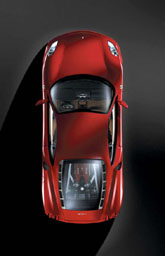
Page 4: Contact
Wide contact patches are key to avoiding banged-up bodywork, and the Ferrari F430 comes standard with 19-inch wheels and Bridgestone performance tires. Goodyear Eagle F1 run-flat rubber, sized 225/35ZR19 in front and 285/35ZR19 in back, are available as an option. Bringing the F430 to a stop is a four-wheel-disc ABS with Electronic Brake-force Distribution (EBD). Brembo cross-drilled carbon-ceramic brake discs that were previously available only on the 360 Challenge Stradale and the Enzo supercar are available at an extra cost.Air intakes in the bumper and just forward of the front and rear wheel wells are designed to help keep the brakes cool, while the engine breathes through scoops mounted high on flanks aft of quarter windows, in a design reminiscent of the 1965 Ferrari 250 LM. Generally, however, the F430’s styling is influenced by the recently introduced 612 Scaglietti and the limited-production Enzo, echoed most prominently in the F430’s vertically-stacked xenon headlights (612) and taillights that bulge outward from the rear deck (Enzo). Inside, a no-nonsense driving environment trimmed in a choice between aluminum or carbon fiber emphasizes the Ferrari F430’s performance intent. The gauge cluster is dominated by a large red- or yellow-faced tachometer, with secondary meters arrayed around the tach, smaller in size but black-faced for easy legibility. Ferrari has installed new leather-upholstered seats in the F430, and better-bolstered race-inspired chairs are available as an option. Ferrari offers neither side-impact nor side-curtain airbags on the F430, but air conditioning and a stereo system are standard equipment.
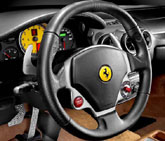
Page 5: Wrap
Reports claim that the first Ferrari F430s will arrive in the U.S. in the summer of 2005, with prices starting around $275,000. Sun worshipers will be glad to know that a planned Spyder version should arrive shortly after introduction, just in time to enjoy the last warm days of summer and get those break-in miles piled on during fall foliage tours before the snow starts to spit from leaden gray skies.Of course, in Ferrari’s biggest markets, such as Los Angeles and Miami, snow is not going to be any trouble at all. Rather, the problem lies in waiting almost a year for Ferrari’s latest road rocket to arrive Stateside. That’s too much time, during which potential customers could become infatuated with the next big thing.
